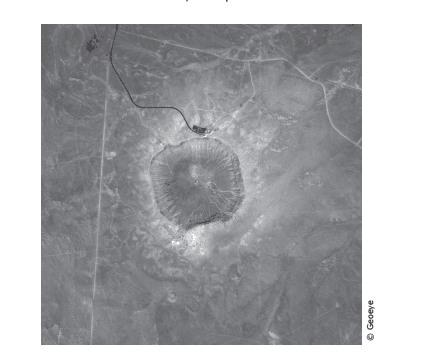
TEKS Grade 8 Science - 8.9.C Interpreting Evidence of Surface Processes
Quiz by Grade 8 Science - Texas Education Agency
Grade 8
Science (2017)
Texas Essential Knowledge and Skills (TEKS)
Feel free to use or edit a copy
includes Teacher and Student dashboards
Measures 1 skill from
Measures 1 skill from
Track each student's skills and progress in your Mastery dashboards
With a free account, teachers can
- edit the questions
- save a copy for later
- start a class game
- automatically assign follow-up activities based on students’ scores
- assign as homework
- share a link with colleagues
- print as a bubble sheet
9 questions
Show answers
- Q1The satellite photograph below shows a large meteorite crater that is 1200 m in diameter and 170 m deep. This crater is located in a flat, arid part of northeastern Arizona. How will this crater most likely change over time?It will rise up like a volcanic crater.It will get deeper as it fills with waterIt will widen as it fills with lava.It will become less deep as the rim erodes.60s8.9c
- Q2A section of a topographic map is shown below. What is the difference in elevation in meters between Point X and Point Y on the map? Be sure to use the correct place value.Users enter free textType an Answer60s8.9c
- Q3The satellite photo below shows San Francisco, California, which has many miles of coastline and an inland bay. Which area of the coastline has most likely experienced the greatest effect of erosion from waves over hundreds of years?Area PArea NArea SArea T60s8.9c
- Q4A student stands at the point marked X on the topographic map below. What height in meters must the student climb in order to reach the top of the hill? Be sure to use the correct place value.Users enter free textType an Answer60s8.9c
- Q5The satellite image below shows a portion of the Namib Desert in Africa. This is an ancient, sandy desert with dunes that can be up to 305 m tall. The Namib Desert extends inland from the Atlantic Ocean between 80 km and 200 km and receives only 5 mm to 76 mm of rain each year. A satellite picture of this same area taken weeks before shows that the shape and location of some sand dunes have changed. Which of these most likely caused the changes in the dunes?Blowing windCrustal upliftOcean wavesFlowing rivers60s8.9c
- Q6The satellite image below shows a ship channel between South Padre Island and Boca Chica beach in South Texas. Sand is sometimes removed from the ship channel through a process called dredging to make it easier for ships to travel through. Recently sand from the bottom of the channel was moved to area beaches. Without this transfer of sand, what would most likely occur in this area in the future?The ship channel would become narrower, and the island would become completely covered with water.The ship channel would become wider, and the island would sink into the Gulf of Mexico.The ship channel would become shallower, and the beach would become narrower.The ship channel would become deeper, and the island would move west toward the mainland.60s8.9c
- Q7The points labeled W and Y on the topographic map below show the campsites of two families. Each family hiked to the elevation on the map marked X. The arrows show the paths taken by both families. What was the change in elevation, to the nearest ten meters, for the family that took the steepest path to Point X? Be sure to use the correct place value.Users enter free textType an Answer60s8.9c
- Q8This satellite photograph shows an area in Alaska after a fire occurred. Which statement best describes the most likely effect the fire had on the river in the 12 months after it occurred?More sediment flowed into the river because the fire disrupted animal habitats and caused animals to leave the area.The amount of vegetation increased and less sediment flowed into the river because the fire produced ash that mixed with the soil.More sediment flowed into the river because the fire destroyed most of the vegetation holding the sediment in place.Less sediment flowed into the river because the fire heated up the soil and made it drier.60s8.9c
- Q9The topographic map shows the location of a park ranger at Point X when a message is received that an injured hiker needs help at Point Z. Which of these is closest to the difference in elevation between the locations of the ranger and the injured hiker?3,650 m910 m2,050 m450 m60s8.9c
